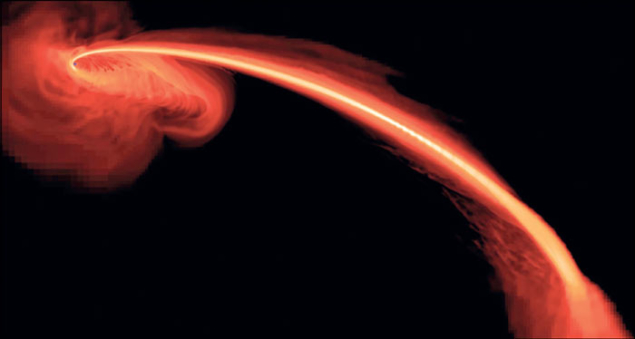
Image credit: NASA, S Gezari/Johns Hopkins University and J Guillochon/Univ. of California Santa Cruz.
Astronomers have gathered the most direct evidence yet of a supermassive black hole shredding a star that wandered too close to it. By following the event over hundreds of days they could identify for the first time the nature of the victim, a helium-rich stellar core.
Supermassive black holes – weighing a few to a thousand million times more than the Sun – are known to exist in the centre of most galaxies and, like volcanoes, they can be active or dormant. In active galactic nuclei (AGN) they receive a continuous supply of gas sustaining their activity, whereas in quiet galaxies – such as the Milky Way – they remain dormant because of the lack of matter to accrete. However, as soon as a star ventures too close to a resting black hole it can suddenly awake in a flare of radiation. Because this happens on average only about once every 10,000 years per galaxy, astronomers have so far detected only a few such events.
Numerical simulations of this kind of event show how the star gets stretched and eventually disrupted in the vicinity of the black hole by the strong gradient of the gravitational field, which exerts more attraction on the near side of the star than on its far side. The observed emission comes from heated gas that is on the verge of falling into the back hole, while the remaining part of the stellar material forms a long tail of gas that is ejected at high speeds.
The new tidal disruption event, published in Nature by Suvi Gezari of the Johns Hopkins University in Baltimore and collaborators, is the first to be discovered in the visible range: all previous ones were detected in X-rays (CERN Courier April 2004 p12, CERN CourierJuly/August 2011 p14). The Pan-STARRS1 telescope on the summit of Haleakala in Hawaii first detected the optical transient PS1-10jh on 31 May 2010. The Panoramic Survey Telescope and Rapid Response System (Pan-STARRS) scans the entire night sky for all kinds of transient phenomena, including supernovae. The event was discovered independently as a near-ultraviolet transient by NASA’s Galaxy Evolution Explorer (GALEX) satellite on 17 June 2010. Subsequent observations by both instruments traced its rise in intensity until 12 July 2010 and its slow decay until September 2011. The flare amplitude in the ultraviolet was found to be much too high for an AGN outburst and its brightness rise too slow to be consistent with a supernova explosion.
By comparing the observed evolution of the brightness with results of numerical simulations of tidal-disruption events, Gezari and colleagues not only confirmed this scenario but could even constrain the internal structure of the incoming star. They find that the star cannot be too centrally concentrated and hence suggest that the doomed star was not a solar-type star but rather a fully convective star or a degenerate stellar core. The latter interpretation is corroborated by a spectral study of the source that shows broad helium-emission lines, but no Balmer lines from hydrogen. This suggests that the outer hydrogen layer of the star was already lost prior to the encounter with the black hole.
A likely scenario is that the star was once a red giant that has lost its hydrogen envelope in one or several previous, less dramatic, fly-bys of the black hole, preserving just a helium-rich stellar core for the final encounter. This stellar core could be only about a quarter of the mass of the Sun and imply a black hole of about 3 million solar masses, which is similar to the one at the centre of the Milky Way. This dramatic event was witnessed by watching a galaxy 2.7 thousand million light-years away. Pan-STARRS is looking at thousands of galaxies for such events and is expected to detect one every two years or so. This will offer new opportunities to probe the effects of general relativity and may even determine whether the supermassive black hole is spinning or not.








